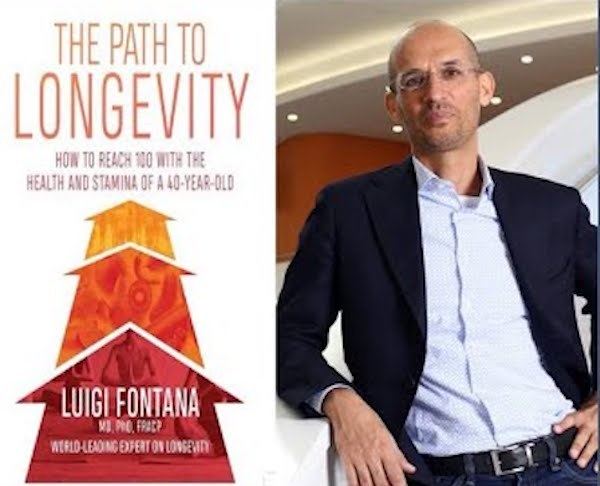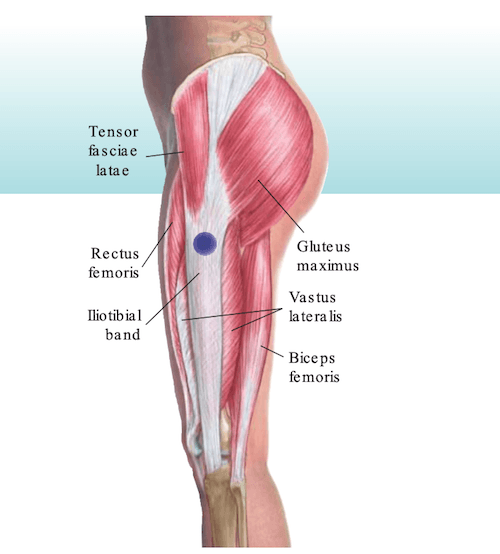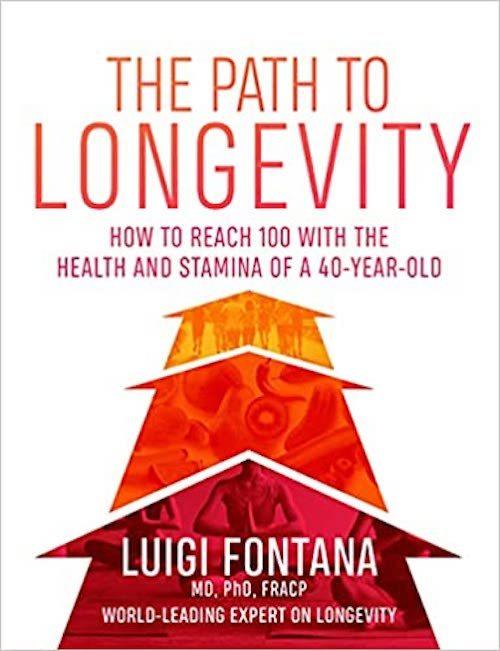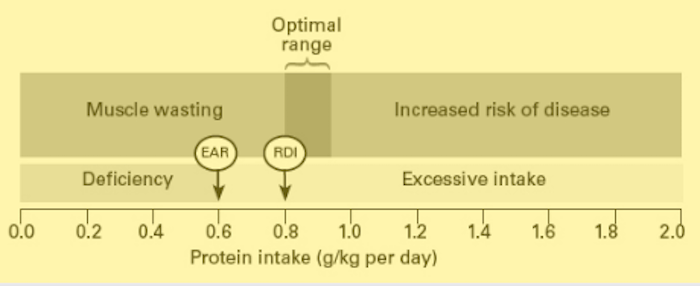Dr. Luigi Fontana and His Longevity Code

Dr. Luigi Fontana is a rare bird — both a medical doctor and PhD longevity researcher, and that’s why I encourage you to read my summary of his 12 longevity precepts and to watch his video. You’ll get actionable information to start getting younger now.
Dr. Luigi Fontana is about to teach you the 12 precepts of this “longevity code”, and a whole lot more, should you by his book.
Go straight to the Table of Contents
As Wikipedia tells the tale, Professor Fontana, M.D., PhD, FRACP is an internationally recognized physician scientist who studies healthy longevity, with a focus on calorie restriction, endurance exercise and metabolism. He is currently the Leonard P Ullmann Chair in Translational Metabolic Health at the Charles Perkins Centre, where he directs the Healthy Longevity Research and Clinical Program. He is also a Professor of Medicine and Nutrition in the Faculty of Medicine and Health at the University of Sydney and a Clinical Academic in the Department of Endocrinology at the Royal Prince Alfred Hospital in Sydney, Australia.
What makes Dr. Luigi Fontana particularly interesting to me is his role as a physician scientist who studies gerontology, the study of the social, cultural, psychological, cognitive, and biological aspects of aging. There are very few people like him in the world that can apply the research he does as a PhD researcher to patients in a clinical context as an MD. In fact, unlike most gerontologist researchers, much of Dr. Fontana’s research is with humans, as opposed to the typical animal models, flies, worms and rodents.
All this led me to begin reading his book, The Path to Longevity: The Secrets to Living a Long, Happy, Healthy Life, and to watch several of his YouTube videos. I’ve become a fan, and want to turn you on to this remarkable man and his insights about how you can improve your healthspan, if not your lifespan, so that you can live long and strong, as we like to say hereabout.
Let’s begin with a summary of is video, Fontana Code for Healthy Longevity: 12 Precepts, and then the video itself. Next I’ll share two golden nuggets of information I’ve discerned so far from reading his book. Finally, I’ll end with links to his research and YouTube Playlists so that you can dive into an particular topic that whets your fancy.
Content
The Dr. Luigi Fontana Code for Healthy Longevity
What follows are the 12 longevity precepts that Dr. Fontana distilled over many years of medical practice, scientific study, the prolific reading of many articles books, and discussions with friends in academia around the world.
My suggestion is that you begin with the lowest hanging fruit. That means, do first what’s within your grasp, the thing that you have the least resistance to doing. Once you’ve got that rolling, grab something else, till all 12 are in your basket.
#1 Reduce Your Waist Circumference
Work to reduce your waistline and to increase (or maintain) your muscle mass, especially in the gluteal femoral region.
Your waist circumference is too big if your waist-to-height ratio is 0.5 or more.
To measure waist-to-height:
- Use a cloth measuring tape, and measure halfway between the top of your hip bones, and the bottom of your rib cage (which for me is just over my belly button).
- Stand up straight, breathe in deeply, exhale, relax (don’t suck in your waist) and then see what the tape measure tells you.
You want your waist-to-height ratio to be half your height; ideally less.
I’m 75.5 inches tall and my waist circumference is 36.5 inches, so: 36.5/75.5 = 0.48, which is a tad under half my height (0.50).
Read: What Your Waist to Height Ratio Reveals About Your Health and How A Plant-based Diet Can Improve It.
Moving to the gluteal femoral strengthening recommendation, this is where the glute (butt) and femoral (leg) muscles are located:
To exercise your gluteal femoral region, do various types of squats:
Watch this demonstration of a triple squat progression:
Here are some more squat variations.
#2 Be Physically Active
Limit the time you spend sitting and move as often as possible.
I spend most of my working hours on my arse. To remind me to get up and move, I set my cell phone to chime once an hour. Sometimes I’m right in the middle of something and don’t want to be disturbed; nonetheless, most times I tear myself away from my work, get up and do one to two minutes of some physical activity, such as squats, core work, jumping jacks, or just walk around.
Read How To Counteract Sitting To Improve Your Health.
Do at least one hour of physical exercise each day, alternating between exercises for:
- Aerobics,
- Strength, and
- Mobility (flexibility and balance)
I cover all three in my post, Longevity Exercise: 7 Anti-aging Interventions Backed By Science.
#3 Eat Healthy Foods
Consume a healthy diet means consuming a wide variety of minimally processed whole grains, legumes (beans and lentils), vegetables (greens and cruciferous), nuts (especially walnuts), seeds (sunflower, chia, hemp and flax), and fruits (especially berries).
Reduce pesticides and herbicide exposure by eating organic foods, or at least washing them thoroughly with a produce wash and cleaner.
Eat mostly proteins from plants (legumes, tofu, seeds, nuts), seafood, and low-fat diary products. If you don’t want to exclude meat, choose lean cuts of grass feed, no-hormone, no-antibiotic animals.
Avoid processed meat, ultra processed food and beverages, sugar-laden beverages, and unhealthy fats, such as trans fats (hydrogenated), and saturated fats (red meat, whole milk and other whole-milk dairy foods, cheese and coconut oil).
Use extra virgin, cold pressed olive oil, but do so in moderation given the high caloric content of oils, in this case about 120 calories per tablespoon.
#4 Tips for the Overweight
I could have entitled this, Tips for Everyone, because most of us are overweight.
If you’re overweight, and especially if you’re lugging around a bunch of body fat, do this:
- Stop eating when you’re 80% full.
- Once or twice a week, consume only raw or cooked vegetables, or beans dressed with two tablespoons of olive oil, lemon (or vinegar) and spices. Of course, do eat veggies and beans as much as you can, but for one or two days, eat them exclusively.
- Consume all your food within a window of eight to ten hours. Do this during designated meal times, and avoid snacking in between. This is referred to as “Time Restricted Feeding”, or “Intermittent Fasting”, which I’ve written much about.
- Eat your food slowly. This has been shown to independently reduce the risk of metabolic syndrome. (By the way, this is my biggest challenge.)
#5 Limit or Avoid Alcohol
If you don’t drink, don’t start. If drinking is already a habit, work to reduce the amount consumed to prevent cancer, cardiovascular disease and neurogeneration (ie: cognitive decline), says Dr. Fontona, who goes on to encourage that you do not drink every day, but rather limit it to a couple of times per week.
Although he said nothing about the number of drinks to have when drinking, I think it’s safe to bet that he wouldn’t support getting sloshed each time you drink.
#6 Don’t Smoke
Yeah, a no-brainer, but worth mentioning because some people think there’s wiggle room when using e-cigarettes or not inhaling. Not true.
#7 Get Some Sun Exposure
Treat your skin to a healthy amount of moderate sun exposure, such as ten to 15 minutes per day on as much of your body that privacy permits. Full body sun exposure in limited bouts has been shown to be very healthy. Do not use sunbeds.
Unless you live near the tropics, and especially if you have brown or black skin, take vitamin D supplements during the winter, because this is very important to keep plasma levels of vitamin D at optimal levels.
Vitamin D is important for your bone health to prevent osteoporosis, and a recent study has shown that 2,000 units per day of vitamin D supplementation over five years was responsible for a 20% reduction in autoimmune diseases.
# 8 Deep Sleep
Sleep is a powerful medicine. Try to sleep at least seven hours a day. Restorative sleep is important to reduce brain inflammation, to get rid of waste and to consolidate memory.
Dig into my posts about restorative sleep.
#9 Nourish Your Mind
It’s very important to never stop learning. Keep stimulating your brain plasticity by continuously acquiring new skills and abilities. This can include learning new languages, reading, poetry, music — anything that will improve brain plasticity, which refers to the ability of neural networks in the brain to change through growth and reorganization.
Nurture your emotional intuitive and creative intelligence by engaging in activities that are important to increase your emotional intuition and creativity. Such activities will force certain parts of your brain to boost synapses and grow synaptic networks.
When you work to acquire a challenging skill, the more parts of your brain gets hypertrophic (enlarged), leading to the ability to perform these new activities as a common part of your life.
It’s also very important to cultivate self control, says Dr. Luigi Fontana, as well as mental equanimity, optimism and happiness, which reinforce synaptic networks.
#10 Nurture Friendships and Brotherhood
This is extremely important for your well-being, mental health and immune health.
Take care of your relatives and friends with love and dedication. Don’t be egotistic, but rather cultivate altruism, and develop the art of peace and compassion.
These are key for human well-being.
#11 Focus on Interiority
Yeah, I had to look it up.
“Interiority” refers to one’s inner life or substance or psychological existence.
Interiority is the place where one takes care of oneself; therefore, carve out the time you need for meditation, engaging in artistic activity and philosophical studies.
Learn to live in the present and according to your own inner nature. Align your thoughts and actions with the flow of your life. This is an art form that you cannot read in a book, per se, but need to practice and focus on in order to learn to build confidence, inner strength and create a noble purpose for your life.
Doing this is extremely important for your well-being, says Dr. Fontana, and is much superior to scrambling after material possessions.
Check out my work about mindfulness and meditation.
#12 Love and Respect Nature
Dr. Fontana believes that to love and respect nature is the most important thing to do for your healthy longevity, because our lives as human beings depend on nature.
He implores us to immerse ourselves in nature as much as possible. Go walk in the woods, or alongside the sea or riverbed. Connecting with nature regenerates you, is essential for us as human beings, and for this reason alone, we should protect the environment.
For me, protecting and venerating the natural world is in our self interest, because without it, there’s no us.
Read my post, Let Nature Strengthen Your Immune System.
Dr. Luigi Fontana’s Code for Healthy Longevity Video
Although I’ve summarized above what Dr. Fontana presents in his video below, I think it’s well worth 14 minutes of your time to watch it.
This is the research that underlies the assertions that Dr. Luigi Fontana makes in his video:
Transdisciplinary research and clinical priorities for better health:
A discussion of a range of science-based strategies, policies, and structural reforms to design an entire new disease prevention–centered science, educational, and healthcare system that maximizes both human and environmental health.
Medical research to treat ageing:
The problems of old age come as a package. More than 70% of people over 65 have two or more chronic conditions such as arthritis, diabetes, cancer, heart disease and stroke. Studies of diet, genes and drugs indicate that delaying one age-related disease probably staves off others. At least a dozen molecular pathways seem to set the pace of physiological aging.
This study reviews the ways in which nutrient-sensing pathways are central to aging. Studies in several model organisms have shown that dietary restriction without malnutrition, or manipulation of nutrient-sensing pathways through mutations or drugs, can increase life span and reduce age-related disease.
Beyond Calories: An Integrated Approach to Promote Health, Longevity and Well-Being:
Evidence from experimental studies suggests that aging is not inevitably linked with the development of chronic diseases, and the age-associated accumulation of molecular damage can be prevented or greatly delayed by dietary and genetic manipulations that downregulate key cellular nutrient-sensing pathways.
Promoting Health and Longevity through Diet: From Model Organisms to Humans:
Reduced food intake, while avoiding malnutrition, can ameliorate aging and aging-associated diseases in invertebrate model organisms, rodents, primates, and humans. Recent findings indicate that meal timing is crucial, with both intermittent fasting and adjusted diurnal rhythm of feeding improving health and function, in the absence of changes in overall intake. Lowered intake of particular nutrients rather than of overall calories is also key, with protein and specific amino acids playing prominent roles. Nutritional modulation of the microbiome can also be important, and there are long-term, including inter-generational, effects of diet. The metabolic, molecular, and cellular mechanisms that mediate both improvement in health during aging to diet and genetic variation in the response to diet are being identified. These new findings are opening the way to specific dietary and pharmacological interventions to recapture the full potential benefits of dietary restriction, which humans can find difficult to maintain voluntarily.
Calorie restriction and cancer prevention: metabolic and molecular mechanisms:
The probability of developing cancer is remarkably high in the US, with approximately 44% of the men and ~37% of the women will develop cancer during their lifetime. Although genetic inheritance influences the risk of cancer, most of the variation in cancer risk across populations and among individuals is due to lifestyle and environmental factors. Data from experimental and epidemiological studies indicate that excessive adiposity (body fat) due to excessive energy intake and minimal physical activity increase the risk of developing cancer. In contrast, calorie restriction without malnutrition, and possibly protein restriction, prevent cancer.
Book Nuggets
The Path to Longevity is a summary of more than 20 years of research, clinical practice, and Dr. Luigi Fontana’s accumulated knowledge about healthy longevity, using an evidence-based approach. Rather than trying to treat sick people with medicine, he shows how we can avoid the chronic illnesses in our society, and live long, healthy and happier lives.
I’ve read less than a third of the book so far, but that led me to Dr. Fontana’s videos and his research, all of which has intrigued me strongly enough to share it with you now, as opposed to waiting till I’m done, at which point I’ll probably write a review about the book in its entirety.
That said, I want to share two things from the book The Path to Longevity: The Secrets to Living a Long, Happy, Healthy Life:
- The interconnectivity between four lifestyle factors and chronic disease, and
- How much protein should you aim to ingest.
Unhealthy Lifestyle and Health Risk
The diagram below shows the interconnectivity between unhealthy lifestyle “effectors”.
Excessive calorie intake, poor diets, sedentary lifestyle, mental stress, and smoking modulate important metabolic and hormonal factors associated with the development of the most common chronic illnesses. 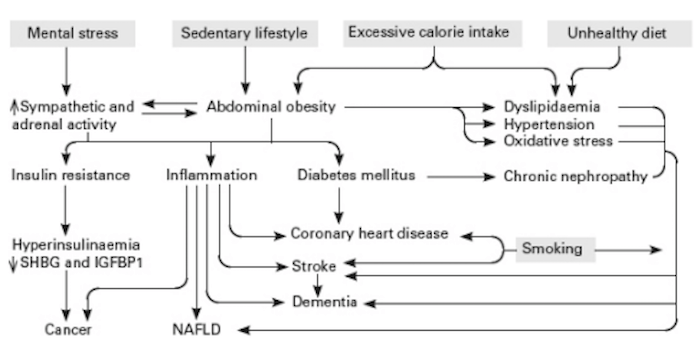
You can see from the diagram that four effectors (something that causes or brings about something else) — mental stress, sedentariness, caloric excess and an unhealthy diet — have numerous, intersecting downstream impacts on health.
What I like about this diagram is that it’s a snapshot of the various chronic diseases that the majority of us face as we age, and their associated causes.
What is a healthy protein intake?
Proteins are essential nutrients. We need them to maintain health. But there’s much confusion about how much protein to consume.
According to the Institute of Medicine, a non-profit organization affiliated to the National Academies of Science in the United states, the estimated average requirement for adults (RDI) is 0.6 grams per kilogram of body weight a day.
The Academy has proposed that the recommended daily intake for protein needed to meet the requirements of 97.5% of the population is 0.8 g per kilogram of body weight a day. This means that if your body weight is 70 kg or 158 lb, you should consume about 58 grams or 2 oz of protein per day in terms of the European Food Safety Authority population reference intake.
By the way, this value is more or less what the centenarians of Okinawa, Japan had been consuming for centuries, and they are the longest-lived, most healthy population in the world. This means that too many people eat much more than they need, which is on average, 1.3 grams per kilogram of body weight every day. In a 70 kg man that means 90 grams or 3.17 oz per day.
This chart extracted from Dr. Luigi Fontana’s book indicates the optimal range of protein consumption per day:
I suggest that you shoot for between 0.6 and 0.8 grams of protein per kilogram of body weight (divide pounds by 2.2 to get kilos) if you are sedentary or do light to moderate weight-bearing exercise (calisthenics, weight lifting). If you are over 65 years of age, or regularly push yourself with your weight-bearing exercise, consider consuming between 0.8 and 1.0 grams of protein per kilogram per day.
From his book:
“Well-conducted clinical studies show that the synthesis of new skeletal muscle protein reaches a plateau when we consume about 30 g of protein at each meal.27,28 All the excess is oxidised and at the same time activates the pro-ageing IGF/mTOR pathway. Eating more protein than what is needed, therefore, will not increase muscle mass, but will accelerate ageing and increase the risk of developing many chronic diseases.”
For more from Dr. Fontana regarding protein, check out this study he conducted.
For my piece on the best protein sources, read 8 Sure-fire Ways to Trim Body Fat and Keep It Off Forever: The Best Quality Protein.
I will undoubtedly have lots more to say about Dr. Fontana’s book once I’ve finished it, so stay tuned for that. (Get on the email list to be notified.)
Dr. Luigi Fontana’s Research and YouTube Playlist
Dr. Fontana’s Research
Google Scholar lists nearly 200 research papers representing the work of Dr. Fontana and his associates. Here are a handful that might spark your interest:
- Extending healthy life span—from yeast to humans
- Interventions to slow aging in humans: are we ready?
- Aging, adiposity, and calorie restriction
- Diet drives convergence in gut microbiome functions across mammalian phylogeny and within humans
- Visceral fat adipokine secretion is associated with systemic inflammation in obese humans
- Long-term calorie restriction is highly effective in reducing the risk for atherosclerosis in humans
- Low protein intake is associated with a major reduction in IGF-1, cancer, and overall mortality in the 65 and younger but not older population
Luigi Fontana’s YouTube Playlist
Dr. Fontana’s YouTube home page
His Playlist:
- Exercise is medicine
- Science of healthy longevity: interviews and lectures
- Nutrition, health and longevity
- Whole foods plant-based diets
- Emotional health, mindfulness, meditation, sleep and slow breathing
- Philosophy of wellbeing
Last Updated on April 11, 2023 by Joe Garma

